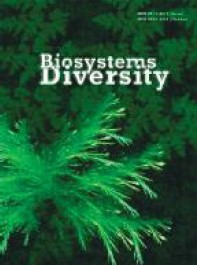Cenopopulation of Epipactis helleborine (Orchidaceae) in forest ecosystems that have been anthropogenically transformed to various degrees
Cenopopulation of Epipactis helleborine (Orchidaceae) in forest ecosystems that have been anthropogenically transformed to various degrees
Author(s): O. P. ChornousSubject(s): Physical Geopgraphy, Environmental Geography
Published by: Дніпропетровський національний університет імені Олеся Гончара
Keywords: short-rooted forest orchids; late-successive biogeocenosises; locations of biodiversity; cenopopulation studies; ontogenetic structure;
Summary/Abstract: Because of developed symbiotic connections of the root system of trees, mycorrhiza-forming fungi and the orchid family Orchidaceae in forest ecosystems of the northeast Polissia Region – cultivated Pinus sylvestris, which are now 100–120 years old, recovery of cenopopulations of Epipactis helleborine has been observed in locations of mixed and broad-leaved forests. In natural plant cover of mature pines of the region, indigenous vegetation is gradually recovering – there occur young Quercus robur, Tilia cordata, Acer platanoides of various ages, crown density of understory formed by Coryllus avellana has reached 0.6, above-ground organic leaf foliage that is able to sustain moisture and increase fertility of soil accumulates, creating sufficient conditions of shading for seedlings and juvenile individuals of forest orchids. Special studies revealed a relationship between density of E. helleborine specimens and crown density of the tree stand, shrub strata, structure of soil cover, expressed in cenoses under various degrees of recreational pressure. Density of individuals of forest orchids in the studied populations ranges 10.0 to 0.1 ind./10 m2. Dynamics were seen in groupings of Betuleto-Pineta corylosa, Querceta (roboris) corylosa, Querceto-Pineta corylosa, Acereto (platanoidis) –Tilieto (cordatae) – Quercetum (roboris) aegopodiosum in the territory of the naturereserve fund and structurally similar anthropogenically pressurized cenoses. We determined that all examined cenopopulations in old indigenous zonal cenoses in the territory of the nature reserve fund are normal, they may be considered relatively stable, ontogenetic spectra are incomplete, mostly with right-sided age spectrum – maximum numbers of virgin and generative individuals of various stages. Low density of individuals and incomplete spectra of cenopopulations in light oak forests are natural, and now the largest share of generative and virgin individuals is concentrated in this area. Impact of recreation, unavoidable due to proximity to a road, is a negative factor directly decreasing their density. Ontogenetic spectra of all cenopopulations are incomplete – no seedlings were found in the natural conditions due to underground type of germination. Much more interesting data may be obtained by monitoring studies of age and morphometric dynamic changes during several years.
Journal: Biosystems Diversity
- Issue Year: 30/2022
- Issue No: 2
- Page Range: 198-204
- Page Count: 7
- Language: English

